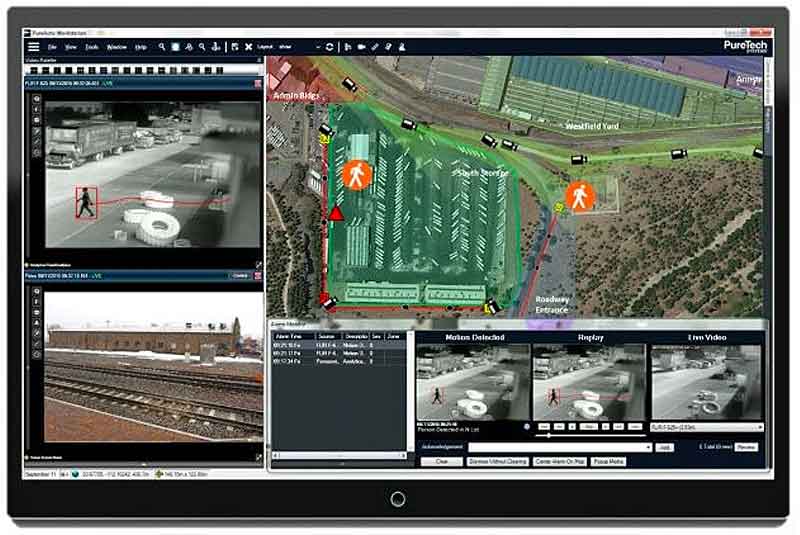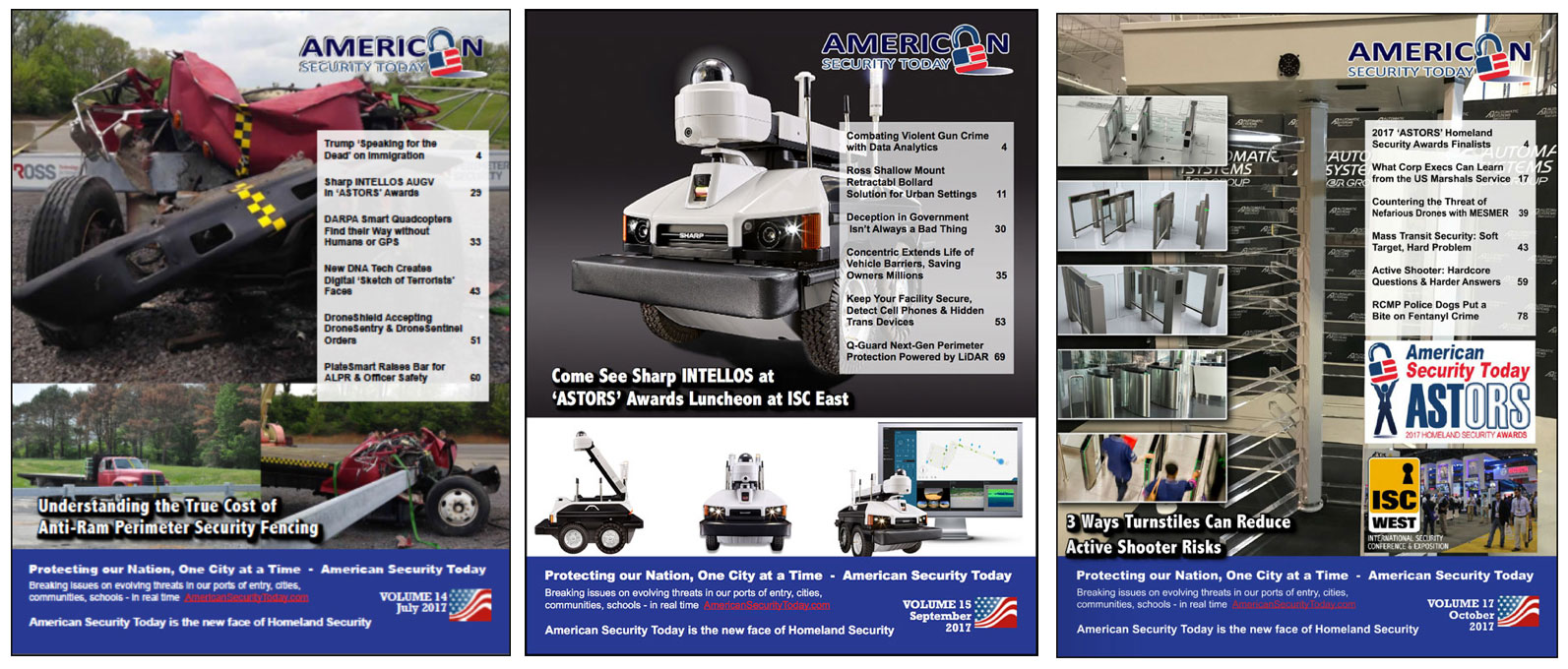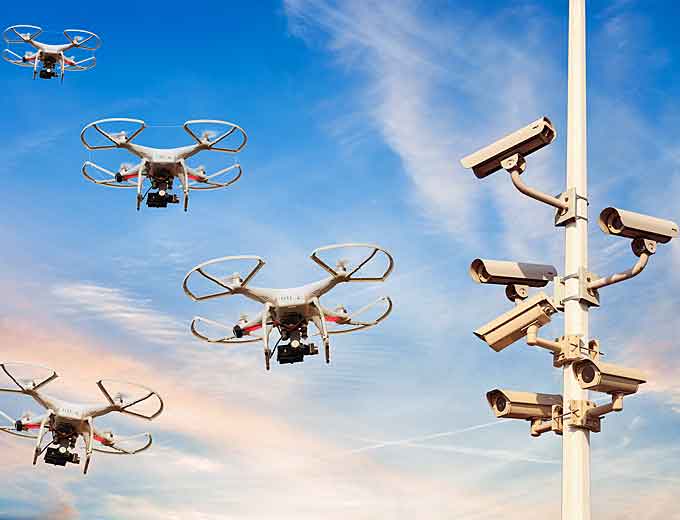
Best Mobile Surveillance ISR
What was once just science fiction, along with artificial intelligence and driverless cars, surveillance drones are now very real and an affordable and effective video surveillance option.
Here are the top reasons you should consider integrating a drone into your video management system.
#1 – Technology Advancements
So why are we suddenly talking about drones?
They’ve been around for quite some time, in fact military records go back to World War I in 1916.
Mini and Micro versions have been around since the early 90’s. So, what’s changed? Mainly capability and affordability.
Over the last few decades, and more rapidly in the last few years, advancements in lighter and more powerful batteries and smaller camera technology has allowed for lighter payloads, which equates to lower cost and longer operating cycles.
Likewise, improvements in wireless video and gimbal technology removes vibration and flight effects of the drone, allowing for high quality, streaming video from the drone to the VMS for continuous surveillance.
When properly integrated with your VMS system, the consideration to use a drone is almost similar to adding a new PTZ camera to obtain longer range.
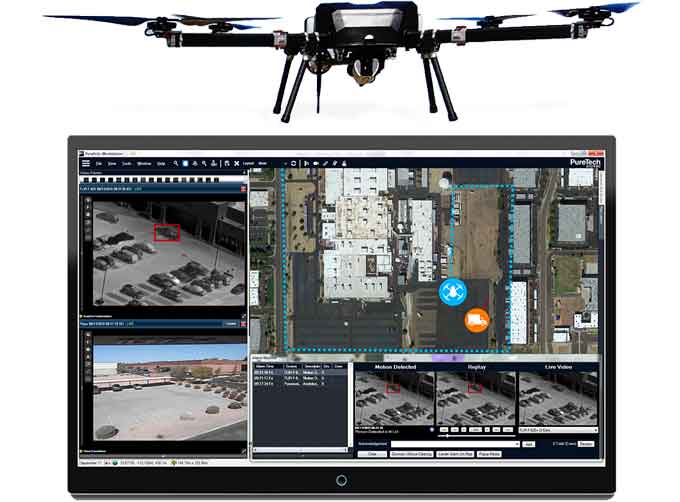
#2 – Dispatch to Alarms
One of the most obvious and likely the highest value proposition of integrating a drone into your VMS system is the Dispatch to Alarm capability.
Most of today’s high-performance VMS systems are geospatial, or map-based. (If your VMS is not geospatial, shame on you, it’s time to give up the Motorola Startac flip phone and get an iPhone X!).
Geospatial video management systems understand the physical location of security detection points (gates, doors, windows), as well as, real-time locations of detected intrusions from video cameras, radars, fence or proximity sensors.
This allows it to easily dispatch a drone to an exact location using the geographical coordinate of the event.
Without any user interaction, the system can turn on the drone, initiate take off, load the destination information and even provide waypoints to guide the flight path.
The drone can arrive in a fraction of the time of a traditional response action to provide additional video of the event.

#3 – Flexible Surveillance Options
A drone can allow you to place a camera almost anywhere.
This opens up many surveillance options. You may have a region that is too rugged to allow cost effective sensor placement, a drone can help monitor these regions.
They can also respond to non-video sensor alarms, such as radar, GPS, fence systems or even remote access control.
If visual confirmation is required, but there is no PTZ in the area with line of sight to the alarm, a drone can help service this request.
It can also serve as a video source for short term missions, or special events, such as visiting dignitaries, company events or even construction actions which may create temporary breaches in the perimeter.
Drones can augment existing measures, or act as additional surveillance to avoid installation of short term monitoring equipment.
#4 – Airborne Intelligence and Tracking
Just as fixed cameras and PTZ cameras can be armed with intelligence via video analytics, on-board drone cameras can benefit from these same algorithms.
As such, drones have the ability to detect intrusions, classify target, count objects and alarm based on detection zones.
This capability is available in both hover modes and while in flight.
Advanced gimbals, intelligent camera control and software stabilized video provides high quality scenes for operator viewing and intelligent video analysis.
In addition to detection capability, PTZ follow algorithms may also be deployed on drone cameras.
Much like a fixed location PTZ, PTZ follow or camera follow, allows the software to control the pan, tilt and zoom of a camera to keep a target centered in the cameras field of view as the target continues in motion.
When deployed on a drone camera, this ability to keep the target centered in the camera’s view remains true, as both the target and drone move independently.
#5 – After Breach Continuous Coverage
Deployment of PTZ follow algorithms on drone-based cameras allow for another significant capability; the ability to continue to follow the intruder after the breach.
Keeping eyes on the target is critical, but even with a robust PTZ camera design, costs and viewshed issues can cause potential blind spots once the perimeter has been breached.
In these cases, a drone can be deployed to provide coverage in these areas.
Today’s micro and mini sized drones are capable of carrying a camera payload, meaning there are few locations which would not be accessible.
#6 – Expanded Patrol Options
A drone can be a valuable addition to your patrol operations, even without the need to have a person trained to fly it.
Today’s drones can include pre-programmed flight plans, where specific events or scheduled timings can allow the drone to automatically take off and fly its route, actively monitoring for and detecting intrusions along its route.
Likewise, an operator can provide a custom flight path, through interaction with the map-based VMS user interface.
In all cases, when flying in an autopilot mode, video algorithms combined with property elevation models and other sensors allow the drone to maneuver around obstacles and then return to its flight path.
These patrol options can be very beneficial in cases where you have limited manpower for consistent patrols, or if patrols require entrance into rough terrain, or potentially hazardous regions of a facility.
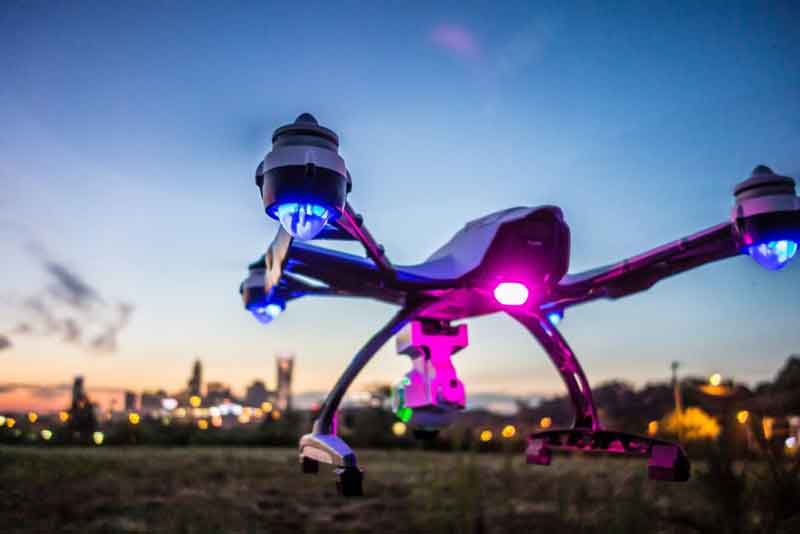
So How Do I Add a Drone to My VMS?
Adding a drone to your surveillance solution can be as easy as placing an order on Amazon and getting your 2-day free shipping, however, much of the value proposition comes from proper integration with your VMS system.
The includes be able to receive the live drone video directly into your VMS, automatic dispatch to an alarm location, display and tracking of the drone location, as well as, the ability to issue basic drone commands directly from the VMS (Track Target, Begin Patrol, Return to Base, Land, etc.).
The Fine Print
When it comes to drones, there is fine print.
Drones hang out in airspace, which in the United States, is the domain of the FAA. As such, drones are subject to the jurisdiction of this agency.
There are still some gotchas when it comes to operational allowances, granting of waivers and line of sight issues.
However, as more drones enter the sky, guidelines and rules are being modified to accommodate.
The good news is, if cars without drivers can motor around our roadways with little to no oversight, then the future looks good for the autonomous use of drones for security on your property.
Want to learn more about geospatial video management systems? Check out PureTech Systems videos and product capabilities.
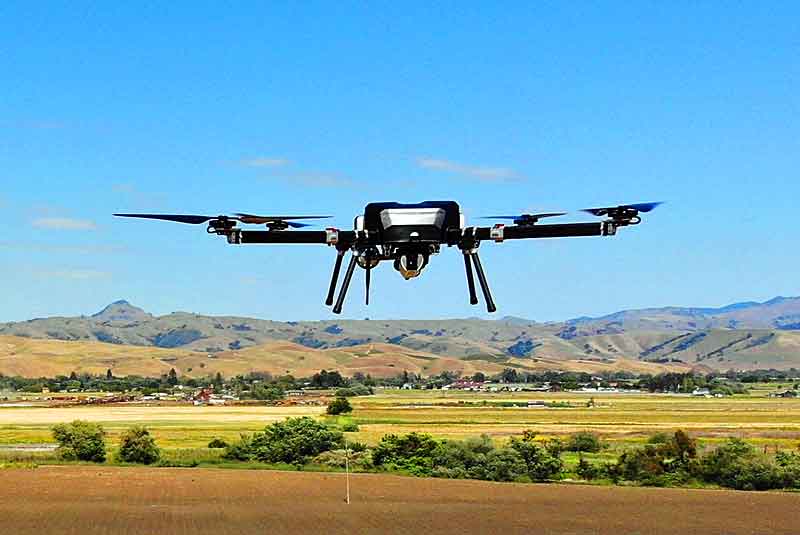
PureTech Systems Takes Platinum in the 2018 ‘ASTORS’ Homeland Security Awards Program
PureTech Systems
-
Best Mobile Surveillance ISR
-
PureActiv
The Annual ‘ASTORS’ Awards Program is specifically designed to honor distinguished government and vendor solutions that deliver enhanced value, benefit and intelligence to end users in a variety of government, homeland security and public safety vertical markets.

The 2018 ‘ASTORS’ Awards Program drew an overwhelming response from industry leaders with a record high number of corporate and government nominations received, as well as record breaking ‘ASTORS’ Presentation Luncheon Attendees, with top firms trying to register for the exclusive high – end luncheon and networking opportunity – right up to the event kickoff on Wednesday afternoon, at the ISC East registration!
Over 130 distinguished guests representing National, State and Local Governments, and Industry Leading Corporate Firms, gathered from across North America, Europe and the Middle East to be honored among their peers in their respective fields which included:
- The Department of Homeland Security
- The Federal Protective Service (FPS)
- Argonne National Laboratory
- The Department of Homeland Security
- The Department of Justice
- The Security Exchange Commission Office of Personnel Management
- U.S. Customs and Border Protection
- Viasat, Hanwha Techwin, Lenel, Konica Minolta Business Solutions, Verint, Canon U.S.A., BriefCam, Pivot3, Milestone Systems, Allied Universal, Ameristar Perimeter Security and More!
The Annual ‘ASTORS’ Awards is the preeminent U.S. Homeland Security Awards Program highlighting the most cutting-edge and forward-thinking security solutions coming onto the market today, to ensure our readers have the information they need to stay ahead of the competition, and keep our Nation safe – one facility, street, and city at a time.
The 2018 ‘ASTORS’ Homeland Security Awards Program was Proudly Sponsored by ATI Systems, Attivo Networks, Automatic Systems, Desktop Alert, and Royal Holdings Technologies.
Nominations are now being accepted for the 2019 ‘ASTORS’ Homeland SecurityAwards at https://americansecuritytoday.com/ast-awards/.
Comprehensive List of Categories Include:
| Access Control/ Identification | Personal/Protective Equipment | Law Enforcement Counter Terrorism |
| Perimeter Barrier/ Deterrent System | Interagency Interdiction Operation | Cloud Computing/Storage Solution |
| Facial/IRIS Recognition | Body Worn Video Product | Cyber Security |
| Video Surveillance/VMS | Mobile Technology | Anti-Malware |
| Audio Analytics | Disaster Preparedness | ID Management |
| Thermal/Infrared Camera | Mass Notification System | Fire & Safety |
| Metal/Weapon Detection | Rescue Operations | Critical Infrastructure |
| License Plate Recognition | Detection Products | And Many Others! |
Don’t see a Direct Hit for your Product, Agency or Organization?
Submit your category recommendation for consideration to Michael Madsen, AST Publisher at: mmadsen@americansecuritytoday.com.
2018 Champions Edition
 See the 2018 ‘ASTORS’ Champions Edition – ‘Best Products of 2018 ‘ Year in Review’ for in-depth coverage of the outstanding products and services of firms receiving American Security Today’s 2018‘ASTORS’ Homeland Security Awards.’
See the 2018 ‘ASTORS’ Champions Edition – ‘Best Products of 2018 ‘ Year in Review’ for in-depth coverage of the outstanding products and services of firms receiving American Security Today’s 2018‘ASTORS’ Homeland Security Awards.’
Enter Early to Maximize Media Coverage of your Products and Services at Kickoff, and Get the Recognition Your Organization Deserves!
And be sure to Register Early for the 2019 ‘ASTORS’ Awards Presentation Luncheon at ISC East 2019 to ensure your place at this limited- space event!













